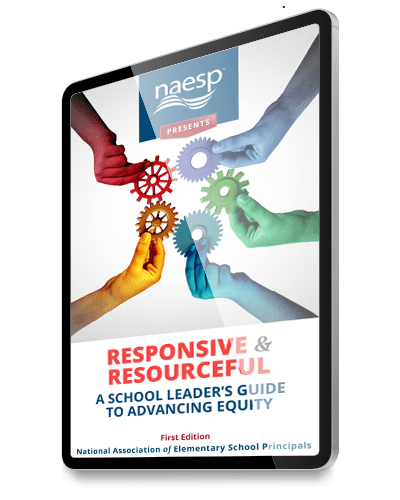
A Journey Toward Equity-Focused Leadership
NAESP’s new ebook delivers practical strategies to support student success.
Topics: Equity and Diversity
NAESP issued the following statement on June 2, 2020, as the nation reacted in horror to the senseless killing of George Floyd in Minneapolis:
“Schools are becoming more racially segregated, achievement gaps still persist, and approximately 80 percent of principals and 80 percent of teachers are white, while the majority of students are racial minorities. Especially because of this imbalance, we urge school leaders to prepare themselves to lead equity in their school communities by deepening their understanding of the impact of race, racism, white privilege, inequality, and police violence.”
It went on to explain NAESP’s stance in supporting principals with the resources they need to “ensure their teachers and students gain a greater understanding of the impact this violence has on affected communities and to offer a safe space in which they can process their emotions,” and recommitting to advancing school leaders as equity champions.
Soon after, the NAESP Board of Directors formed the NAESP National Task Force on Race and Equity to advise the association on issues related to racial equity in school communities, reveal schools’ common challenges and solutions, and support a peer-to-peer network of support for school leaders.
The task force got to work identifying principals’ specific needs in leading schools with an equity lens. “Leading equity can be a daunting responsibility,” said Kimbrelle Barbosa-Lewis, former president of NAESP and chair of the NAESP National Task Force on Race and Equity. “We all know how important it is, but it can be hard to know how to get started, how to prioritize it, and how to make sure that teachers and staff have the mindset and skills they need to move it forward.”
Simultaneously, schools were experiencing what was described as a dual pandemic, as the effects of COVID-19 and the nation’s racial reckoning dramatically altered back-to-back school years.
NAESP’s Leaders We Need Now research series explains how the pandemic and social injustice forced principals to shift priorities to meet new demands. Funded by The Joyce Foundation and conducted by the American Institutes for Research, the study assessed principals’ responsibilities according to the Professional Standards for Educational Leaders (PSEL), revealing that principals were forced to put standards focused on equity, cultural responsiveness, curriculum, and school improvement on the backburner.
“The COVID-19 pandemic and sudden shift to distance learning exacerbated inequities related to educational access,” said NAESP Executive Director L. Earl Franks, Ed.D., CAE. “But in exposing these shortcomings, it offered principals a jumping-off point to address systemic disparities and build support for an ecosystem that advances culturally responsive leadership for principals nationwide. Now that everyone can recognize how these inequities affect students, we can engage even more diligently in breaking them down.”
New Ebook Outlines Equity-Focused Leadership
In editing NAESP’s Principal magazine and developing resources for principals, assistant principals, and other educational leaders, I’ve had the unique opportunity to both facilitate dialogue with school leaders about their practice and collaborate with dozens of researchers, practitioners, and thought leaders to develop a collection of resources that provide practical guidance in equity leadership.
The resulting resources are featured in NAESP’s new ebook, Responsive and Resourceful: A School Leader’s Guide to Advancing Equity, and are organized around the four leadership behaviors that produce positive school outcomes, as outlined in How Principals Affect Students and Schools, a research report commissioned by The Wallace Foundation:
- Facilitating Collaboration and PLCs. Principals can build leadership capacity by understanding implicit and explicit biases, building racial literacy, and creating a common language of equity in your school.
- Engaging in Instructionally Focused Interactions With Teachers. Culturally responsive leadership impacts curriculum and teaching. Here’s how educators can encourage students of every background to see themselves in their learning.
- Building a Productive Climate. Principals can use inclusive SEL, introduce restorative approaches to discipline, and address antiequity rhetoric to advance equity efforts in their schools and create resilient, self-aware students.
- Managing Personnel and Resources Strategically. Whom the school employs can affect its inclusivity. Leverage hiring and staffing to build a school culture that reflects the student body and community while advancing school goals.
Principals play a critical role in leading equity efforts and creating positive change in their schools. The articles, webinars, and resources in this ebook emphasize the importance of creating and fostering a culture of equity and engaging in practices that support all students’ access to a fair and inclusive education.
Using this ebook, educational leaders can take advantage of a variety of practical strategies to create inclusive and equitable learning environments that support every student’s success. Advancing equity requires principals to adapt to changing circumstances in a fractious political atmosphere, but principals must lead the charge instead of accepting the status quo.
Kaylen Tucker is associate executive director, Communications, at NAESP and editor in chief of Principal magazine.
This article was originally published as the Foreword to Responsive and Resourceful: A School Leader’s Guide to Advancing Equity.

Download Responsive and Resourceful: A School Leader’s Guide to Advancing Equity

